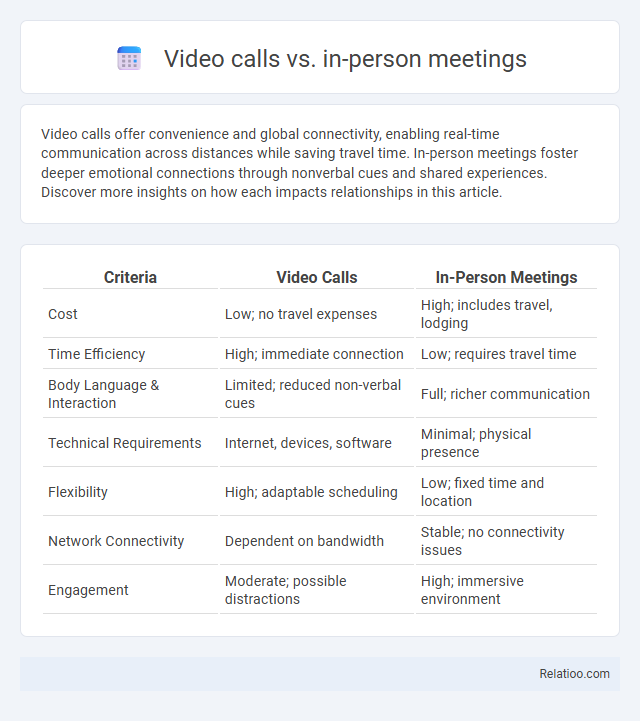Video calls offer convenience and global connectivity, enabling real-time communication across distances while saving travel time. In-person meetings foster deeper emotional connections through nonverbal cues and shared experiences. Discover more insights on how each impacts relationships in this article.
Table of Comparison
| Criteria | Video Calls | In-Person Meetings |
|---|---|---|
| Cost | Low; no travel expenses | High; includes travel, lodging |
| Time Efficiency | High; immediate connection | Low; requires travel time |
| Body Language & Interaction | Limited; reduced non-verbal cues | Full; richer communication |
| Technical Requirements | Internet, devices, software | Minimal; physical presence |
| Flexibility | High; adaptable scheduling | Low; fixed time and location |
| Network Connectivity | Dependent on bandwidth | Stable; no connectivity issues |
| Engagement | Moderate; possible distractions | High; immersive environment |
Introduction: The Rise of Video Calls
The rise of video calls has transformed communication by enabling real-time visual interaction regardless of geographic distance, making remote collaboration feasible for businesses and individuals worldwide. Technologies like Zoom, Microsoft Teams, and Google Meet have surged in popularity, supporting flexible work arrangements and reducing travel costs. While video calls offer convenience and immediacy, in-person meetings still provide richer non-verbal cues and spontaneous creativity, and imagination continues to play a crucial role in problem-solving and idea generation beyond physical or virtual constraints.
Defining In-Person Meetings and Video Calls
In-person meetings involve face-to-face interactions where participants engage physically in the same location, fostering real-time communication through body language and immediate feedback. Video calls utilize digital platforms such as Zoom, Microsoft Teams, or Google Meet to enable remote visual and auditory connections, breaking geographical barriers while relying on internet bandwidth and device capabilities. Both methods serve distinct purposes: in-person meetings excel in building rapport and nuanced understanding, whereas video calls offer flexibility and accessibility for distributed teams.
Communication Clarity: Face-to-Face vs. Screen-to-Screen
Face-to-face communication enhances clarity through nonverbal cues such as body language, facial expressions, and eye contact, fostering deeper understanding and immediate feedback. Video calls offer visual and auditory interaction but can suffer from lag, limited field of view, and screen fatigue, which may reduce overall message clarity. Imagination allows for mental visualization and abstract thinking but lacks real-time interpersonal cues, making it insufficient for precise and nuanced communication compared to in-person or video interactions.
Productivity and Efficiency Comparison
Video calls enhance productivity by enabling remote collaboration without travel time, offering real-time visual and auditory communication that supports efficient decision-making. In-person meetings foster deeper engagement through non-verbal cues and spontaneous brainstorming, which can boost creativity and complex problem-solving efficiency. Your choice between video calls, in-person meetings, or imagination-driven brainstorming depends on balancing immediate interaction needs with flexible, creative thinking processes to maximize overall productivity.
Cost and Time Savings
Video calls significantly reduce travel expenses and save hours otherwise spent commuting, making them a cost-effective alternative to in-person meetings. In-person meetings, while offering richer personal interaction, often incur higher costs and time investments due to logistics and scheduling constraints. Your choice between video calls and face-to-face gatherings should weigh the balance of efficiency and quality, with imagination playing a key role in enhancing virtual communication to bridge the physical gap.
Building Trust and Relationships
Video calls offer visual cues and real-time interaction, enhancing communication but may lack the full depth of face-to-face meetings, which foster stronger trust through personal presence and nonverbal signals. In-person meetings build authentic connections by engaging all senses, making relationship development more impactful and genuine. Your imagination supports trust-building by allowing you to visualize positive outcomes and empathize with others' perspectives beyond physical or virtual interactions.
Accessibility and Flexibility
Video calls offer unparalleled accessibility by connecting participants regardless of geographic constraints, while in-person meetings provide a tangible, immersive experience that enhances communication through non-verbal cues. Imagination transcends physical and technological limitations, enabling creative problem-solving and conceptual exploration beyond the boundaries of both video calls and face-to-face interactions. The flexibility of video calls allows for real-time collaboration across time zones, whereas in-person meetings require scheduled coordination, and imagination fosters continuous, unrestricted cognitive engagement.
Security and Privacy Concerns
Video calls raise significant security and privacy concerns due to risks like unauthorized access, data breaches, and weak encryption protocols, making sensitive conversations vulnerable. In-person meetings offer higher control over confidentiality as physical presence limits digital interception, but still require secure environments to prevent eavesdropping. Imagination, being entirely internal and offline, eliminates external cybersecurity threats and data leakage risks, ensuring absolute privacy and security.
Challenges and Limitations of Each Method
Video calls often face challenges such as limited non-verbal cues, technical issues, and digital fatigue, which can hinder effective communication. In-person meetings offer richer interaction and immediate feedback but are constrained by geographical limitations, time consumption, and higher costs. Imagination, while flexible and free from logistical barriers, suffers from subjectivity and lacks concrete feedback, making it less reliable for collaborative decision-making.
Choosing the Right Approach for Your Needs
Video calls offer real-time interaction and visual cues, making them ideal for remote collaboration and quick decision-making. In-person meetings foster deeper connections and facilitate complex discussions through non-verbal communication and shared environments. Imagination allows for creative brainstorming and conceptual planning without physical constraints, proving essential for innovation and strategic thinking.

Infographic: Video calls vs in-person meetings
 relatioo.com
relatioo.com